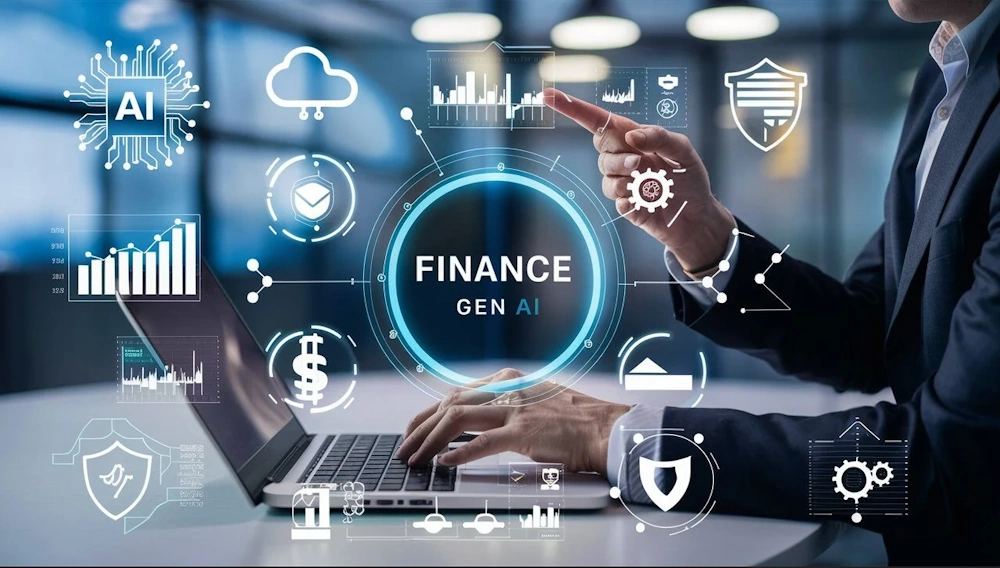 AI in Finance
AI in Finance
A set of technologies that enables organizations to better understand markets and customers, analyze and learn from transactions, and engage in a way that mimics human intelligence
Related: AI Industry | AI Companies | AI Stocks
AI in Finance applies advanced algorithms and machine learning to analyze data, automate tasks, and improve decision-making. AI uses natural language processing for faster and more accurate responses to customer inquiries, and AI agents and AI-powered search for productivity gains.

 Benefits of AI in Finance
Benefits of AI in Finance
- Cost reduction in operations
- Increased efficiency and productivity through automation
- Improved accuracy in data processing and decision-making
- Enhanced regulatory compliance and transparency
- Better customer experiences through personalization
- Iimproved security in online banking and with credit cards

How is AI used in Finance?
Here are some specific areas where AI is used in the financial industry:
- Automation and efficiency: AI can automate repetitive and time-consuming tasks, allowing financial institutions to process large amounts of data faster and more accurately.
- Compliance: AI can automate monitoring and reporting requirements to ensure regulatory compliance.
- Credit scoring: AI can analyze a variety of data, including social media activity and other online behavior, to assess customers' creditworthiness and make more accurate credit decisions.
- Commodities trading: AI can be used to develop trading algorithms that can analyze market trends and historical data to make decisions and execute trades faster than humans.
- Cost reduction: By automating tasks with AI, financial institutions can reduce manual labor, streamline workflows, and improve operational efficiency.
- Customer service: AI-powered personal assistants and chatbots can reduce the need for human intervention, provide personalized customer service such as real-time credit approvals, and offer consumers improved fraud protection and cybersecurity.
- Data analysis: AI can analyze massive amounts of data and extract insights and trends that would be difficult for human data scientists to detect, enabling more informed decision-making and a deeper understanding of market behavior.
- Fraud detection: AI algorithms can prevent financial crime, such as fraud and cyberattacks by identifying unusual patterns in financial transactions, and improving security in activities such as online banking and credit card transactions.
- Loan processing: AI can better predict and assess loan risks, and streamline the process and approvals for borrowers by automating tasks such as risk assessment, credit scoring, and document verification.
- Personal finances: AI tools can help people manage their personal finances by analyzing goals, spending patterns, and risk tolerance to develop budgeting advice and savings strategies.
- Portfolio management: AI can analyze market conditions and economic indicators to help investors make better decisions and optimize their portfolios.
- Predictive analytics: AI can enable predictive modeling, which can help financial organizations anticipate market trends, potential risks, and customer behavior.
- Risk management: AI can analyze data to help financial organizations assess and manage risks more effectively and create a more secure and stable financial environment.
- Sentiment analysis: AI can analyze news, social media, and other sources to gauge market sentiment, which can help predict market trends and influence decision-making.
Financial Customer Service
AI is improving customer service with chatbots, virtual assistants, and more
AI enables 24/7 support, personalized advice, proactive assistance, fraud detection, and improved efficiency, leading to happier customers and higher revenue. Conversational AI and natural language processing power chatbots that allow banking customers to access account information quickly and efficiently. Generative AI can help create emails, service replies in chat, and provide knowledge articles that make it easier to offer more relevant and personalized service. AI can predict consumer behavior and understand their purchase preferences. This enables more personalized interactions, faster and more accurate customer support, credit scoring refinements, and new products and services.
Chatbots: Erica from Bank of America, COiN from JP Morgan Chase, Eno from Capital One.
Learn More:
dialzara.com/blog/5-ai-customer-service-success-stories-in-banking
salesforce.com/blog/customer-service-in-banking

Fraud Detection
AI algorithms can prevent financial crime
AI fraud detection has become a critical tool in combating financial and digital fraud, leveraging advanced algorithms and machine learning to analyze large datasets for patterns and anomalies indicative of fraudulent activities. AI technologies allow for the analysis of vast amounts of transaction data in real time, identifying patterns that could indicate fraud. Machine learning algorithms can be trained to recognize both known and emerging fraud patterns, adapting to new tactics over time. This includes supervised learning, where models are trained on labeled data, and unsupervised learning, where models identify anomalies without prior examples of fraud.
Learn More:
infosysbpm.com/blogs/bpm-analytics/fraud-detection-with-ai-in-banking-sector
digitalocean.com/resources/articles/ai-fraud-detection
 Links
Links
ibm.com/think/topics/artificial-intelligence-finance
onlinedegrees.sandiego.edu/artificial-intelligence-finance